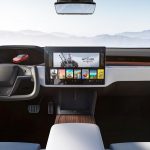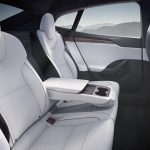
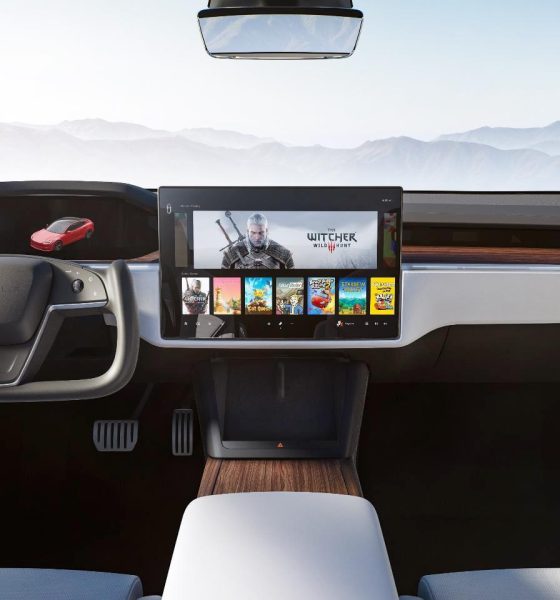
News
Tesla teases Model S Plaid with refreshed interior: New touchscreen, Roadster steering wheel, and more
Tesla revealed new images of the 2021 Refreshed Model S, showing an updated interior with a new, horizontal dash screen, a new steering wheel, wood grain trim, an updated center console, and a rear passenger touchscreen.
The Model S Refresh has been rumored to be taking place for several months. In December, the company shut down Model S and Model X production lines, initiating the thought that its long-standing sedan and SUV would get the updating they deserve.
- Tesla Model S interior touchscreen (refresh) Credit: Tesla
- Tesla Model S interior rear seat touchscreen armrest (Credit: Tesla)
The revamped interior includes a horizontal dash screen, hailing the design from the Model 3 and Model Y. Previously, the Model S and X both had a vertical touchscreen, spanning from the top of the dash to the center console. Tesla has taken a few pieces of inspiration from the new Model 3 interior and a wireless charging mechanism available below the center screen.
The steering wheel is reminiscent of the Tesla Roadster, with its half-circle design. Tesla has also made the Model S interior even more minimalistic than before, removing air-conditioning and heat vents. Utilizing the Airwave HVAC, the new design has the vents hidden and seems also to be inspired by the Model 3 and Model Y interior. The revised system will have tri-zone controls, allowing for customized airflow options for maximum comfortability.
The Model S also received a newly-designed center console that is a clean, one-piece design. The Model 3 also received an updated center console and storage area, using a sliding door design instead of a traditional swinging architecture. For more storage, door pickets have also been added to the Model S, a feature that has long been absent from the sedan.
Three Displays
“With 2200×1300 resolution, ultra-bright colors with exceptional responsiveness and left-right tilt, the new center display is an ideal touchscreen for entertainment and gaming anywhere. A second display in front of the driver shows critical driving information, and a third display provides entertainment and controls for rear passengers.”
Credit: Tesla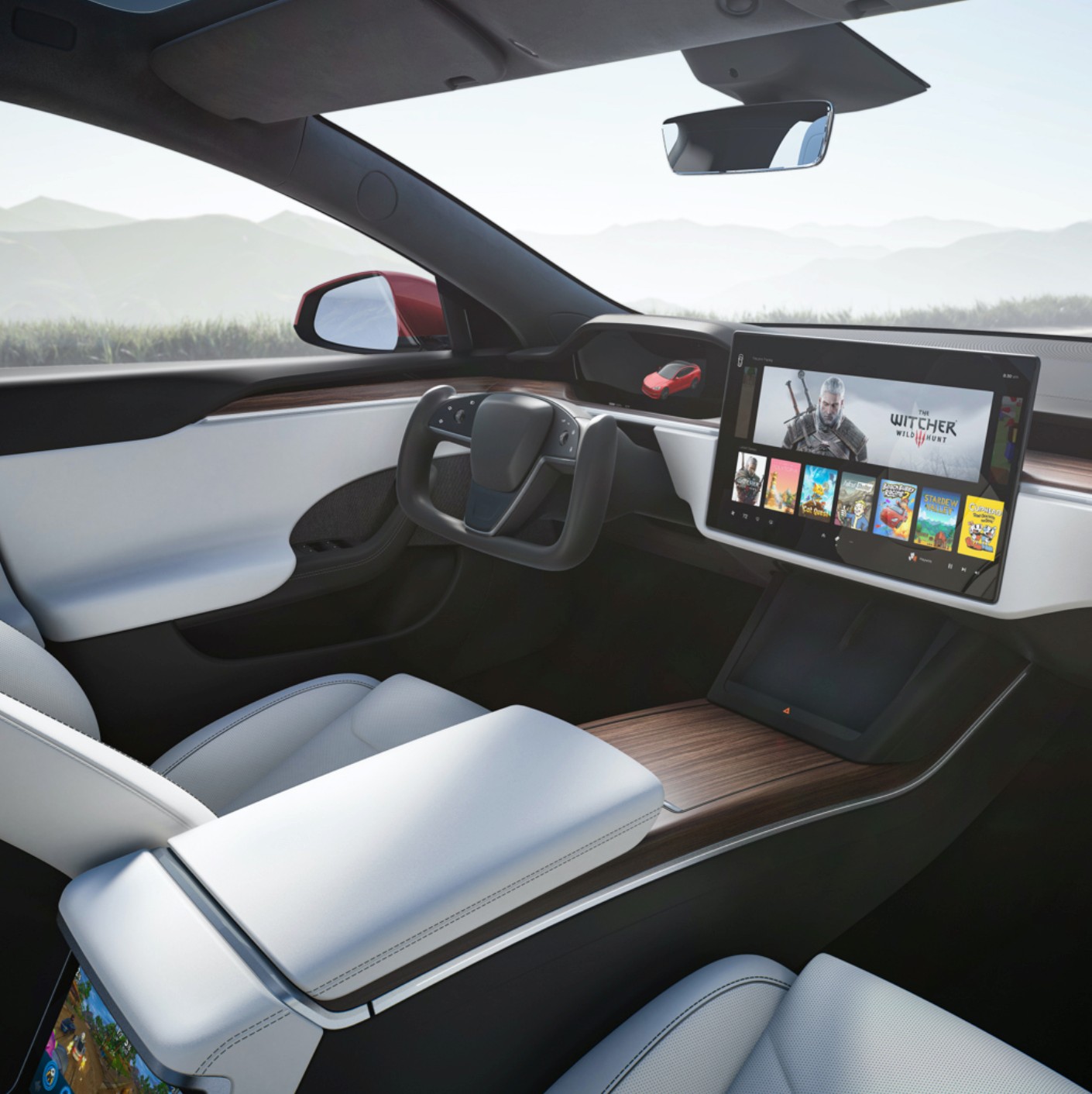
Game from Anywhere
“Up to 10 teraflops of processing power enables in-car gaming on-par with today’s newest consoles via Tesla Arcade. Wireless controller compatibility allows gaming from any seat.”
Credit: Tesla
Tri-Zone Climate Controls
“Airflow and temperature are controlled entirely through the displays without any physical vents. On hot days, Cabin Overheat Protection ensures interiors always stay cool. In cold weather, pre-conditioning automatically warms the cabin and prepares the battery for maximum range.”
Credit: Tesla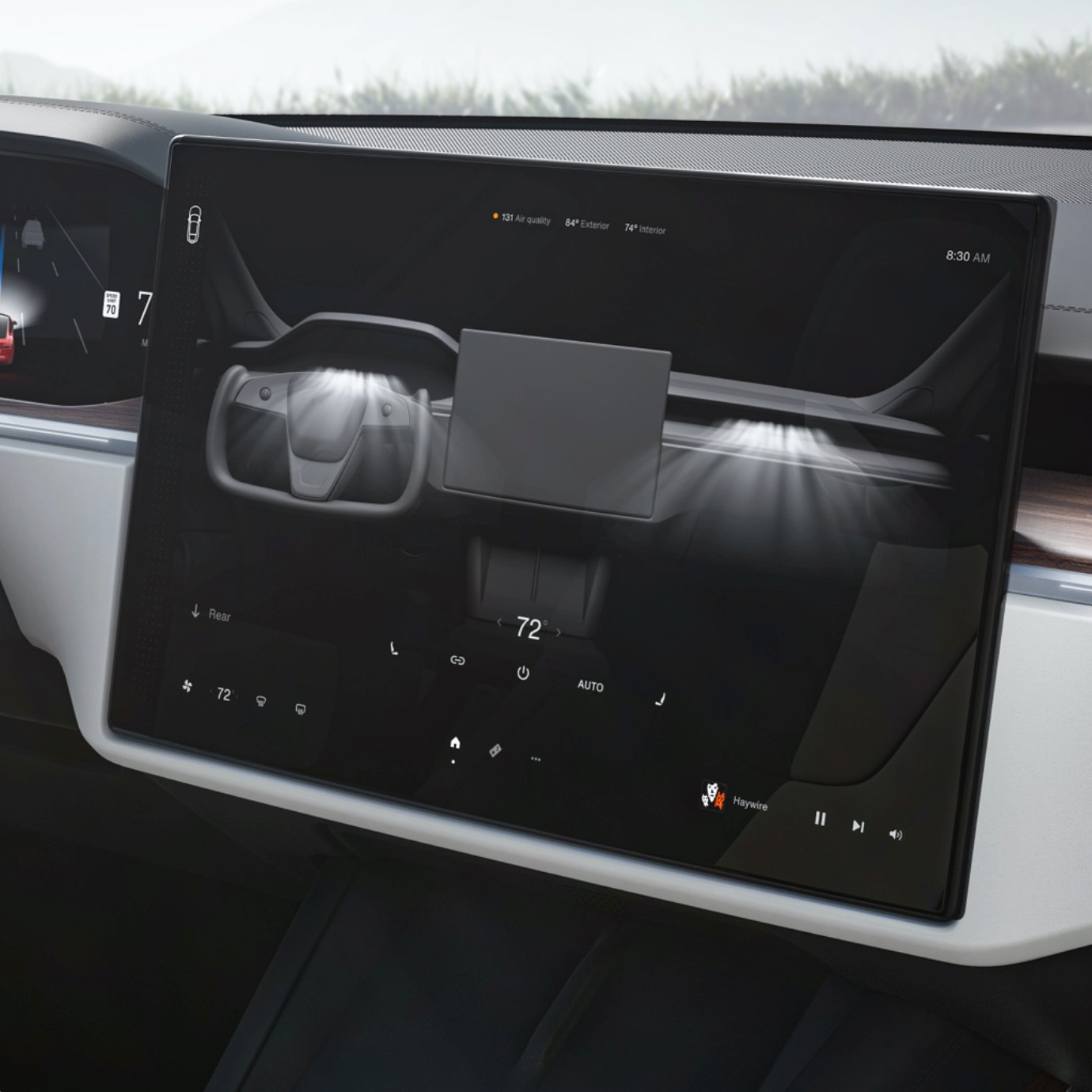
Yoke Steering
“The ultimate focus on driving: no stalks, no shifting. With a stalkless steering yoke, you can enjoy both the best car to drive, and the best car to be driven in.”
Credit: Tesla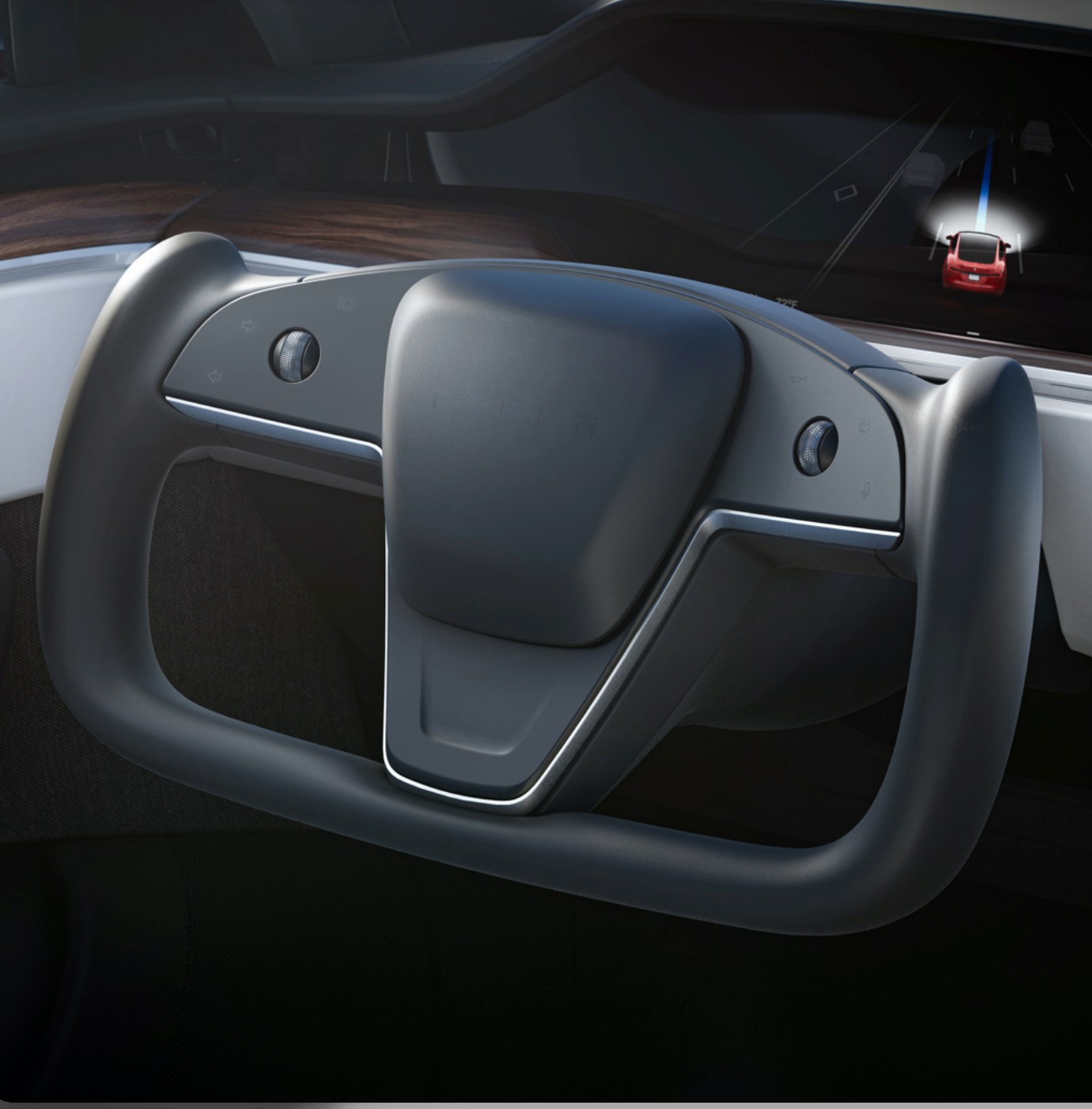
Glass Roof
“The full Glass Roof gives passengers a brighter, more spacious experience and unobstructed views of the sky. Infrared and UV light is effectively blocked before entering the cabin, reducing heat and glare even when the sun is directly overhead.”
Credit: Tesla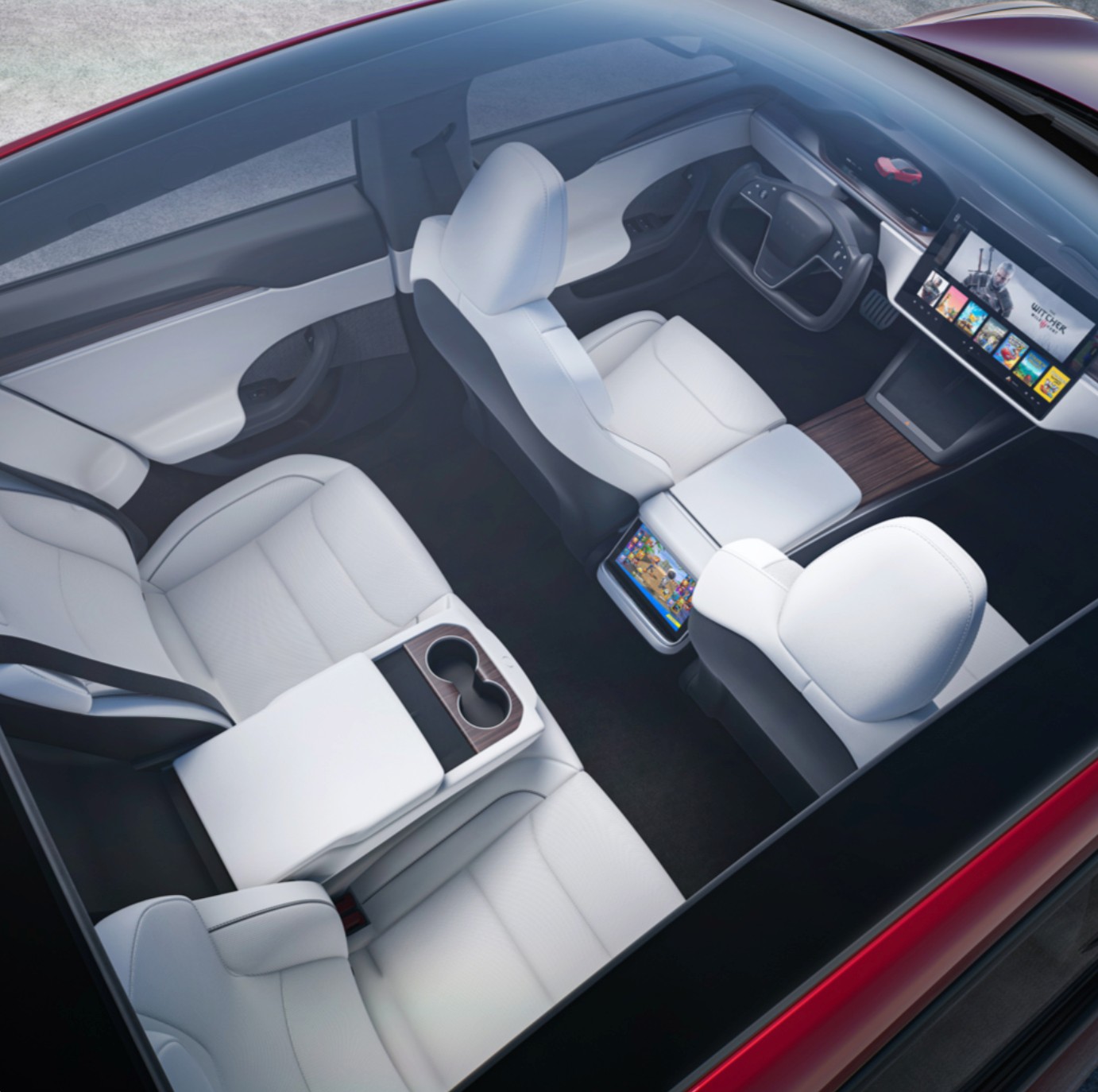
In the rear of the vehicle, the passengers will be given the opportunity to have their own small, centrally-located dash screen, which seems to be displaying a game. This indicates that passengers in the back will not get to miss out on all of the fun that the front occupants have, as they will now be involved in all of the gamification and fun that Tesla offers with its cars. Although not displayed, rear climate controls will also likely be available on this screen, keeping every passenger comfortable.
Teslarati spotted the new Model S at the Fremont Factory this past weekend, showing a newly revised body style that keeps the flagship sedan’s classic look with a few updated features. Wider body designs, coupled with several cosmetic updates, and performance modifications give the Tesla Model S the new design it surely deserves.

News
Tesla Model 3 named New Zealand’s best passenger car of 2025
Tesla flipped the switch on Full Self-Driving (Supervised) in September, turning every Model 3 and Model Y into New Zealand’s most advanced production car overnight.

The refreshed Tesla Model 3 has won the DRIVEN Car Guide AA Insurance NZ Car of the Year 2025 award in the Passenger Car category, beating all traditional and electric rivals.
Judges praised the all-electric sedan’s driving dynamics, value-packed EV tech, and the game-changing addition of Full Self-Driving (Supervised) that went live in New Zealand this September.
Why the Model 3 clinched the crown
DRIVEN admitted they were late to the “Highland” party because the updated sedan arrived in New Zealand as a 2024 model, just before the new Model Y stole the headlines. Yet two things forced a re-evaluation this year.
First, experiencing the new Model Y reminded testers how many big upgrades originated in the Model 3, such as the smoother ride, quieter cabin, ventilated seats, rear touchscreen, and stalk-less minimalist interior. Second, and far more importantly, Tesla flipped the switch on Full Self-Driving (Supervised) in September, turning every Model 3 and Model Y into New Zealand’s most advanced production car overnight.
FSD changes everything for Kiwi buyers
The publication called the entry-level rear-wheel-drive version “good to drive and represents a lot of EV technology for the money,” but highlighted that FSD elevates it into another league. “Make no mistake, despite the ‘Supervised’ bit in the name that requires you to remain ready to take control, it’s autonomous and very capable in some surprisingly tricky scenarios,” the review stated.
At NZ$11,400, FSD is far from cheap, but Tesla also offers FSD (Supervised) on a $159 monthly subscription, making the tech accessible without the full upfront investment. That’s a game-changer, as it allows users to access the company’s most advanced system without forking over a huge amount of money.
News
Tesla starts rolling out FSD V14.2.1 to AI4 vehicles including Cybertruck
FSD V14.2.1 was released just about a week after the initial FSD V14.2 update was rolled out.

It appears that the Tesla AI team burned the midnight oil, allowing them to release FSD V14.2.1 on Thanksgiving. The update has been reported by Tesla owners with AI4 vehicles, as well as Cybertruck owners.
For the Tesla AI team, at least, it appears that work really does not stop.
FSD V14.2.1
Initial posts about FSD V14.2.1 were shared by Tesla owners on social media platform X. As per the Tesla owners, V14.2.1 appears to be a point update that’s designed to polish the features and capacities that have been available in FSD V14. A look at the release notes for FSD V14.2.1, however, shows that an extra line has been added.
“Camera visibility can lead to increased attention monitoring sensitivity.”
Whether this could lead to more drivers being alerted to pay attention to the roads more remains to be seen. This would likely become evident as soon as the first batch of videos from Tesla owners who received V14.21 start sharing their first drive impressions of the update. Despite the update being released on Thanksgiving, it would not be surprising if first impressions videos of FSD V14.2.1 are shared today, just the same.
Rapid FSD releases
What is rather interesting and impressive is the fact that FSD V14.2.1 was released just about a week after the initial FSD V14.2 update was rolled out. This bodes well for Tesla’s FSD users, especially since CEO Elon Musk has stated in the past that the V14.2 series will be for “widespread use.”
FSD V14 has so far received numerous positive reviews from Tesla owners, with numerous drivers noting that the system now drives better than most human drivers because it is cautious, confident, and considerate at the same time. The only question now, really, is if the V14.2 series does make it to the company’s wide FSD fleet, which is still populated by numerous HW3 vehicles.
News
Waymo rider data hints that Tesla’s Cybercab strategy might be the smartest, after all
These observations all but validate Tesla’s controversial two-seat Cybercab strategy, which has caught a lot of criticism since it was unveiled last year.

Toyota Connected Europe designer Karim Dia Toubajie has highlighted a particular trend that became evident in Waymo’s Q3 2025 occupancy stats. As it turned out, 90% of the trips taken by the driverless taxis carried two or fewer passengers.
These observations all but validate Tesla’s controversial two-seat Cybercab strategy, which has caught a lot of criticism since it was unveiled last year.
Toyota designer observes a trend
Karim Dia Toubajie, Lead Product Designer (Sustainable Mobility) at Toyota Connected Europe, analyzed Waymo’s latest California Public Utilities Commission filings and posted the results on LinkedIn this week.
“90% of robotaxi trips have 2 or less passengers, so why are we using 5-seater vehicles?” Toubajie asked. He continued: “90% of trips have 2 or less people, 75% of trips have 1 or less people.” He accompanied his comments with a graphic showing Waymo’s occupancy rates, which showed 71% of trips having one passenger, 15% of trips having two passengers, 6% of trips having three passengers, 5% of trips having zero passengers, and only 3% of trips having four passengers.
The data excludes operational trips like depot runs or charging, though Toubajie pointed out that most of the time, Waymo’s massive self-driving taxis are really just transporting 1 or 2 people, at times even no passengers at all. “This means that most of the time, the vehicle being used significantly outweighs the needs of the trip,” the Toyota designer wrote in his post.
Cybercab suddenly looks perfectly sized
Toubajie gave a nod to Tesla’s approach. “The Tesla Cybercab announced in 2024, is a 2-seater robotaxi with a 50kWh battery but I still believe this is on the larger side of what’s required for most trips,” he wrote.
With Waymo’s own numbers now proving 90% of demand fits two seats or fewer, the wheel-less, lidar-free Cybercab now looks like the smartest play in the room. The Cybercab is designed to be easy to produce, with CEO Elon Musk commenting that its product line would resemble a consumer electronics factory more than an automotive plant. This means that the Cybercab could saturate the roads quickly once it is deployed.
While the Cybercab will likely take the lion’s share of Tesla’s ride-hailing passengers, the Model 3 sedan and Model Y crossover would be perfect for the remaining 9% of riders who require larger vehicles. This should be easy to implement for Tesla, as the Model Y and Model 3 are both mass-market vehicles.
